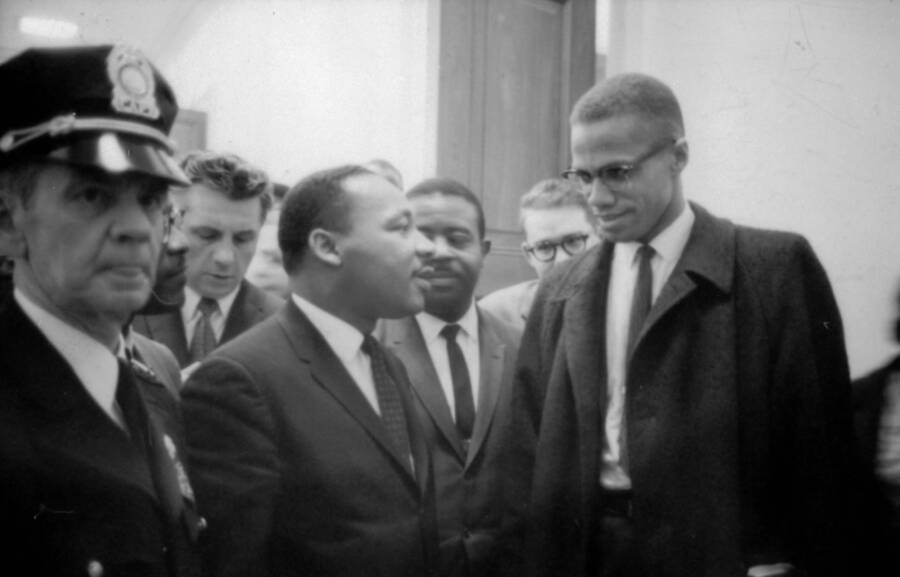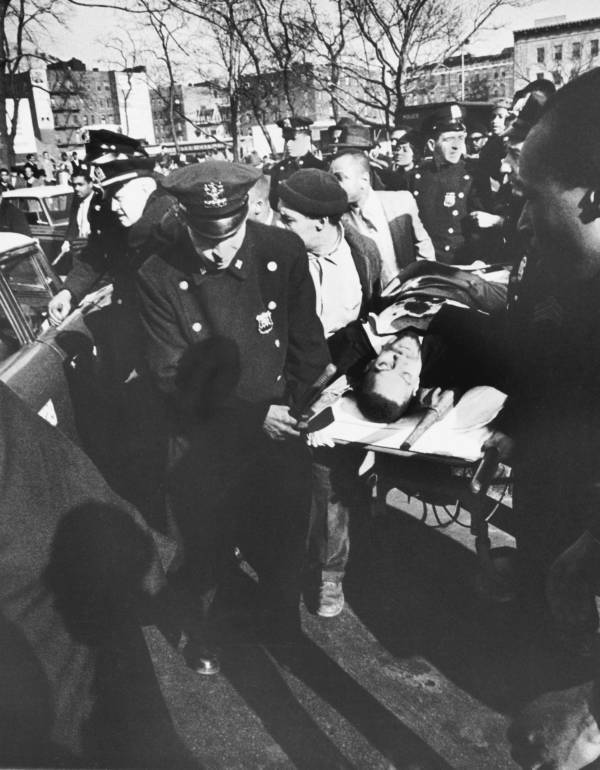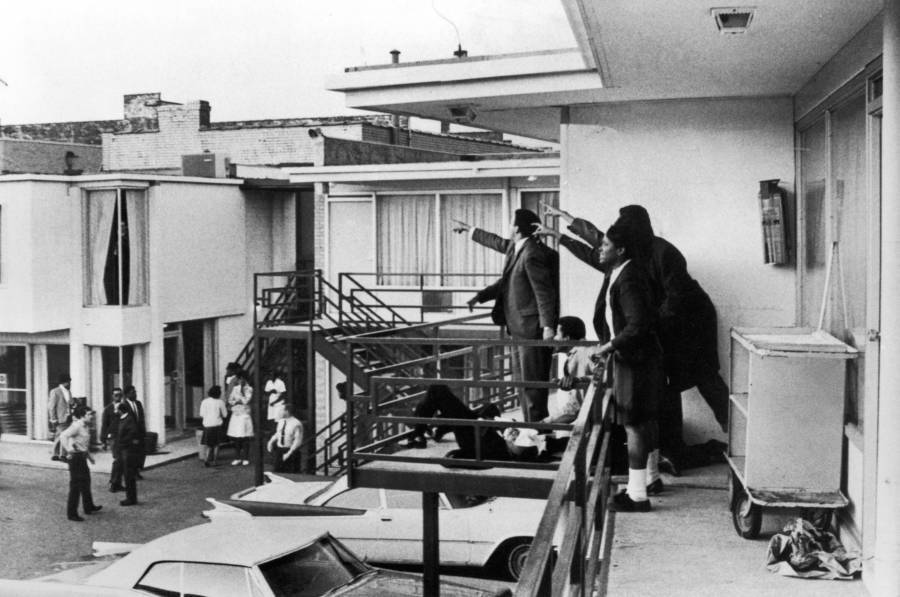On March 26, 1964, Malcolm X and Martin Luther King Jr. met on Capitol Hill and discussed working together in the future — but within a year, one of them was dead.

Universal History Archive/Getty ImagesThough Malcolm X and Martin Luther King Jr. were two of the most renowned Black leaders of the 1960s, they only met one time.
Malcolm X and Martin Luther King Jr. are two of the most iconic figures of the 1960s American civil rights movement. But they only met each other once — briefly, and almost by accident — in 1964.
Their sometimes opposing viewpoints may have kept these two giants of the civil rights movement from meeting more often. Malcolm X argued that King’s insistence on nonviolence would prolong Black suffering in favor of white comfort. On the other hand, King criticized Malcolm’s ideas as being too militant and radical.
However, their fleeting interaction could have been the start of something great. But tragically, within a few short years, both men would be assassinated.

Divergent Views On Civil Rights
Martin Luther King, Jr. and Malcolm X had both emerged as leaders of the civil rights movement by 1964. However, they viewed the challenges faced by Black Americans in the 1960s in different ways, and each prescribed different solutions to cure America’s racial ills.
King, a Baptist minister, encouraged Black Americans to utilize non-violence to achieve their aims. He endorsed protest techniques like sit-ins and peaceful marches.

Wikimedia CommonsMalcolm X in 1964
Malcolm X, who rose to prominence through his affiliation with the Nation of Islam, viewed King’s insistence on non-violence with impatience. Malcolm X labeled King as a “modern Uncle Tom,” and accused him of teaching Black Americans to be “defenseless in the face of one of the most cruel beasts that has ever taken a people into captivity.”
Defending his stance, Malcolm X argued that he supported violence as a means to an end. “I am for violence if non-violence means we continue postponing a solution to the American Black man’s problem just to avoid violence,” he wrote in his autobiography.
King, for his part, viewed Malcolm X as a radical with a dangerous agenda. He did not see violence as a solution and believed that Malcolm X’s rhetoric would increase tensions between Black and white Americans.
“Urging Negroes to arm themselves,” King stated, “and prepare to engage in violence, as [Malcolm X] has done, can reap nothing but grief.”
King saw violence as “self-defeating.” He quoted the Bible, which preached that those who “live by the sword, die by the sword.”

Wikimedia CommonsMartin Luther King Jr. gives his “I Have a Dream” speech. August 1963.
Despite their divergent viewpoints, it seemed possible that Malcolm X and Martin Luther King could work together.
In 1963, Malcolm X invited King to a Harlem rally to discuss civil rights and challenges for Black Americans. King did not attend. Several months later, King gave his famous “I Have a Dream Speech” at the March on Washington.
Malcolm X, although in attendance, did not cross paths with King. He called the occasion “the Farce on Washington” and sneered — perhaps still bitter about King’s refusal to attend the Harlem rally — that, “I observed that circus…Black masses in America were — and still are — having a nightmare.”
When Malcolm X And Martin Luther King Jr. Met For The Only Time
Malcolm X and Martin Luther King, Jr. finally met on March 26, 1964. Neither had planned to meet the other — and the meeting itself lasted only a few minutes.
Earlier that month, Malcolm X had left the Nation of Islam. In a lengthy statement announcing his separation from the movement, Malcolm X signaled an openness toward other civil rights leaders.
He said that he wanted to “cooperate in local civil rights actions” and that his affiliation with the Nation of Islam had prevented him from doing so.

Bettmann via Getty ImagesMalcolm X and Martin Luther King Jr. met in the halls of the US Capitol after attending a Senate hearing on the Civil Rights Act.
“It’s going to be different now,” Malcolm X said. “I’m going to join in the fight wherever Negroes ask for my help.”
A couple of weeks later, the two civil rights leaders crossed paths for the first time.
Both had come to Washington D.C. to attend the Senate debate on the Civil Rights Act of 1964. Their paths crossed as King left a news conference. Malcolm X stepped forward and extended his hand.
“Well, Malcolm,” said King, accepting the handshake as camera bulbs flashed, “good to see you.”
“Good to see you,” Malcolm X replied. The two men walked the short length of the Senate hallway together. During their brief conversation, Malcolm X reiterated what he had said in his statement leaving the Nation of Islam. He wanted to roll up his sleeves and continue the fight for civil rights.
“I’m throwing myself into the heart of the civil rights struggle,” Malcolm X told King.
And like that — the meeting ended. Malcolm X and Martin Luther King Jr. went their separate ways.
A Potential Friendship Ruptured By Assassinations

Underwood Archives/Getty ImagesPolice carry Malcolm X’s body out of the Audubon Ballroom in New York City after he was shot 15 times point blank.
When Malcolm X and MLK parted ways, it seemed likely that they would meet again. Historians, looking back on the moment, noted that King and Malcolm X had begun to move closer together ideologically. Malcolm X’s stance had begun to soften as he reached out to other civil rights leaders.
In The Autobiography of Malcolm X, published in 1965, Malcolm X wrote, “I was no less angry than I had been…[but] anger can blind human vision. America is the first country…that can actually have a bloodless revolution.”
Meanwhile, King had grown more militant. His goals looked past ending segregation. King argued for policies that seemed radical at the time, including eradicating poverty and instituting a universal basic income.
Despite this, King never gave up on nonviolence. He was committed — according to a member of his inner circle, Andrew Young — to “militant nonviolence.”
But in less than a year, Malcolm X would be dead, felled at the hands of assassins in February 1965. King mourned Malcolm X publicly and privately.
In his column in the Amsterdam News, King acknowledged that he and Malcolm X had not agreed on many issues. Yet, wrote King, Malcolm X’s murder “deprives the world of a potentially great leader.”

Joseph Louw/The LIFE Images Collection/Getty ImagesMartin Luther King Jr.’s associates point to the gunman. April 1968.
Privately, King expressed similar sentiments. In a telegram to Malcolm X’s widow, Betty Shabazz, King again conceded that he and Malcolm X had not seen eye-to-eye on many things. Despite this, King wrote of his “deep affection” for Malcolm X.
To Shabazz, he wrote that he respected Malcolm X’s “great ability to put his finger on the existence and root of the problem.” No one can doubt, King said, “that Malcolm had a great concern for the problems that we face as a race.”
Malcolm X and Martin Luther King Jr. approached civil rights in different ways. But these two leaders would meet similar, violent ends. Three years after the slaying of Malcolm X, Martin Luther King Jr. was also assassinated.
In 1988 King’s widow, Coretta Scott King, acknowledged that the two men might have had a great friendship.
“I think they respected each other,” she said. “I am sure that [if they had lived] they would have come closer together and would have been a very strong force in the total struggle for liberation and self-determination of Black people in our society.”
Sadly, the world will never know what these two powerful Black men could have accomplished together.
After reading about Martin Luther King Jr. and Malcolm X, learn about how John Lewis went from Freedom Rider to Congressman. Or, read about Ella Baker, an unsung hero of the Civil Rights movement.





